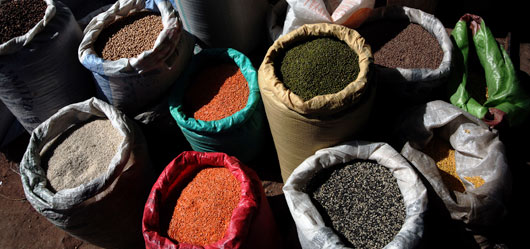FAO's role in seeds
FAO plays a lead role in strengthening the conservation and sustainable use of plant genetic resources for food and agriculture through policy assistance, technical support and awareness raising.
In the broadest sense, this encompasses the whole range of actions involved in the conservation, diversification, adaptation, improvement and delivery to farmers through seed systems.
FAO, in line with the Second Global Plan of Action priority activities, assists member countries in carrying out the following key activities:
- Strengthen seed production programmes, including early generation seed multiplication, taking into account comparative advantages of the public and private seed sectors
- Strengthen national seed associations and support the emergence of local private seed enterprises involved in the production and distribution of seed through improved access to new varieties, capacity-building activities and appropriate credit schemes
- Strengthen farmers’ capacities in seed multiplication in order to improve quality of seed produced in the informal sector particularly in transition from emergency to development activities and where there is no private sector
- Promote value-adding activities at local level as a means of diversifying farmers’ revenues and stimulating seed demand
- Strengthen community seed systems programmes to improve farmers’ knowledge and skills related to varieties and seeds
Seed systems
In many developing countries, farmers do not yet benefit from the advantages of using quality seed due to a combination of factors, including inefficient seed production, distribution and quality assurance systems, as well as the lack of good seed policies and other regulatory instruments.
To address these constraints, FAO works within a range of areas aiming at enhancing seeds in developing countries and encouraging linkages between breeding and seed systems.
Seed production and delivery
There are usually many different groups of stakeholders involved in the production, distribution and marketing of seeds worldwide, including farmers, seed growers, small enterprises, large companies, agricultural research institutes, agricultural input dealers, civil societies and local markets.
FAO promotes the implementation of an integrated approach in improving farmers’ access to good quality seed, encompassing the informal and formal (public and private) seed sectors in the development of national seed supply chains.
Seed security
FAO emergency operations focus on seed security issues to improve farmers’ access to good quality seed of appropriate varieties through seed distribution, seed vouchers and/or seed fairs as may be necessary.
This allows farmers to resume agricultural production after emergencies, thereby minimizing their dependence on food aid.
Stories
- Plant Production and Protection
- The International Treaty on Plant Genetic Resources for Food and Agriculture
- Commission on Genetic Resources for Food and Agriculture
- World Information and Early Warning System (WIEWS ) on Plant Genetic Resources for Food and Agriculture (PGRFA)
- Seed security assessments project webpage
- IPPC - International Plant Protection Convention


